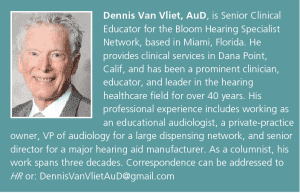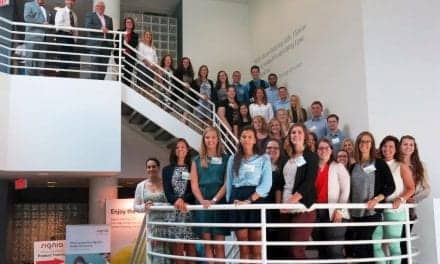Final Word | December 2018 Hearing Review
A recent social media photo post of an early 1980’s behind-the-ear (BTE) hearing aid made me think back to how fitting hearing aids used to be. Some things have changed and many things have not. The 1970’s and early 1980’s BTEs and the few custom aids were ordered as is, with a volume control. We could specify the gain and output by simple rules of thumb, like halving the speech reception threshold (SRT), adding 10 dB for gain, and eyeballing the slope of the 2cc-coupler response, or by using simple calculations to come up with a reasonable “prescription.” We’d specify the vent on the mold for fine-tuning modifications and add acoustic dampers or lamb’s wool in the sound path for fine tuning. I clearly remember discussions about the computer programming of hearing aid parameters and thinking all our problems would be solved if such a magical thing could be invented.
Today, we have algorithms to put our faith in, and machine learning to try and do what we can’t. We still face unrealistic expectations (ours as well as the users’) and plenty of opportunities for counseling. We still think about what magical developments might come about to improve results and user satisfaction.
The future is clouded with unknowns like over-the-counter (OTC) opportunities and advances in implantable devices, but I’m sure that baby-boomer demographics will ensure that there will be plenty of potential hearing aid users who will need our help. I’m not a fan of worrying about what misfortunes may befall our profession in the years ahead, but I do like to imagine how it will be as new technology evolves.
Two recent news items have sparked my imagination. One involves the creepy incidents of foreign diplomats being affected by some kind of transmitted microwave energy that causes balance disturbances and bizarre perceptions. There is speculation that the microwave energy may be directly affecting the brain. Yes, it’s disturbing to think about the weaponization of this energy, but what if this pathway to the brain can be developed to affect the brain in a precise and positive manner to create acoustic perceptions for communication or to calm down an abnormal vestibular system? Imagine a cochlear implant-like effect with no surgery! This idea comes from little fact and a lot of imagination, but the possibilities exist. It could happen sometime in the (distant) future.
Another interesting report came from a 2015 TED Talk (Abe Davis at TED 2015) that I recently heard on a radio interview. Davis, as part of his research in pursuit of a PhD at the Massachusetts Institute of Technology (MIT), used high-speed videography to observe the effect of sound on ordinary objects: houseplants, bags of chips, you name it. The high-speed video captures the minimal motion of objects created by incident sound. The recordings of the movement can be analyzed with software and played back as discernible sound. Recordings played in Davis’ demonstrations are distorted, but recognizable. Of course, my imagination leaped into the distant future to wearable devices with high-speed cameras that could be aimed toward objects near someone just far enough away to not be easily heard. The camera would pick up the motion from, for example, a salt shaker near the speaker, using the video image converted to sound source to augment the signal from the hearing device microphones.
It’s easy to dream about what might be; I’m sure making practical products will be much more difficult. Pass the salt, please!
The Final Word? …is a word of caution. I think we should gladly embrace new technology, but recognize that it needs to come with convenience and ease of use. No matter what magical technology is developed, our target population will have many members who will still need guidance in selecting and using the products. Unfortunately, I’ll need a better way to remember my own passwords if I have any hope of helping future patients with more complicated systems.
Citation for this article: Van Vliet D. Embracing the technological revolution in hearing care. Hearing Review. 2018;25(12)[Dec]:50.
Image: © Zishan Liu| Dreamstime.com






